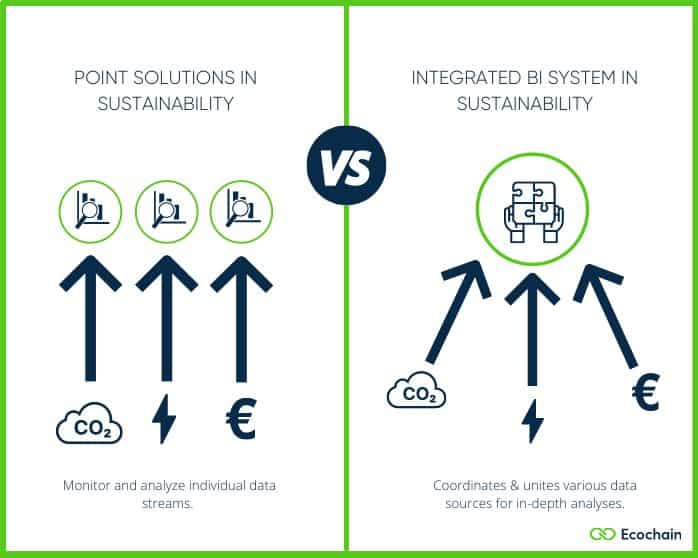Environmental data from your suppliers, your own processes, potential climate risks- you name it.
With the constant pressure from stakeholders and legislation to report credible and transparent environmental performance. Managing your sustainability information efficiently has become vital to sustainable success.
Over the years, most companies have been manually collecting this necessary data for sustainability. A process that is fine in the initial stages- but eventually turns out to be inefficient and error-prone.
How can BI help overcome this inefficiency and increase high-quality sustainability performance? What does that look like in practice?
Point solutions vs. integrated BI solutions in sustainability
The integration of sustainability performance is challenging. Whereas financial information is coming from ‘the inside’. Sustainability information is a blend of internal- as well as external information.
Currently, companies often use point solutions to gather the data they need for sustainability information. These focus on single-use cases such as a ‘product LCA’ platform. For example, they can help you monitor and analyze a certain data stream- such as a carbon footprint of a product. Providing very useful information to further optimize your product.
On the contrary, integrated BI solutions combines various data sources. They are designed to support multiple decision processes and uses one central database (data warehouse), such as Activity-based footprinting. Therefore, these solutions often offer ‘near-real time’ data rather than insights purely based on historic and average data. For example, they can help you connect:
(1) Your real-life energy consumption, with;
(2) The energy costs and;
(3) The correlated environmental footprint data.

Feeding your data warehouse with sustainability information
To make sure they don’t miss out on relevant information. More and more companies are taking the initiative to centralize their sustainability data into a data warehouse.
BI technology or software can help you coordinate and unite the streams of sustainability data from your processes and suppliers. And connect your data warehouse to the right tools/features for analysis. Think of transactional data from e.g. ERP systems (for day-to-day business activities), as well as tools that are used for analysis and reporting- such as Microsoft’s Power BI.
“Whilst a point solution is a champion in fixing one-dimensional issues. Integrated management systems can support complex integrated decisions in sustainability. This includes e.g. decision-making processes in which a company’s ‘footprint’ is weighted versus ‘costs’. Think of decisions with the business case to improve manufacturing processes. ”
Roel Drost – Chief Value Officer at Ecochain technologies
A joint effort between the Sustainability, Finance & IT community
This BI trend in sustainability is also a necessity for the increasing amount of sustainability legislation companies have to prepare for. Therefore; an integrated BI landscape in sustainability now goes hand-in-hand with the involvement of Finance and IT professionals in the world of social & environmental performance indicators.
This results in an interesting synergy. Sustainability professionals are strong in content and Finance & IT professionals are traditional ‘risk & control’ thinkers. Approaches that will only strengthen each other and provide new inspiration for both disciplines. Creating transparency in a company’s environmental and social performance.
Now that we know the benefits of applying BI in sustainability. How do they look like in practice?
The 4 benefits of integrating sustainability into your BI system: the case of hospitality giant Vermaat
Vermaat is the leading specialist in tailor-made catering establishments in the Netherlands. They used Ecochain’s Environmental Intelligence Platform for their environmental footprint calculations. Through an *API, Ecochain’s tool was connected to Vermaat’s own data sources. The BI benefits are:
*API: An API stands for Application Programming Interface. It’s a software intermediary that allows two applications to connect and feed each other with data.
1. Improved environmental measurement performance
Vermaat is a big player in the hospitality business- which means they depend on many suppliers. Often the largest part of a companies’ environmental footprint comes from its supply chain (scope 3 emissions). Therefore, insight into this impact is a crucial factor for improving sustainability efforts. With Ecochain’s tool, Vermaat was able to efficiently gather both their own- as well as their supplier’s environmental data. Creating more in-depth and accurate footprint measurements.
2. Combining multiple large data sources
Ecochain’s tool provides the environmental footprint of each of Vermaat’s products through a web API. After, Vermaat links this data to their own data; the purchase per location. Combining these two important data streams, allows Vermaat to visualize all their data into a dashboard for their customers (upstream supply chain) and their suppliers (downstream supply chain). True BI in action.
3. Empowering sustainable decision-making for stakeholders
The web API from Ecochain allowed Vermaat to create two dashboards. With the Ecochain supplier dashboard, all Vermaat’s suppliers can look into their own environmental footprint. The result: Vermaat and its suppliers can analyze how they can best possibly improve their joint environmental footprint.
With Vermaat’s customer dashboard their customers (restaurants) are provided with the right information to make more sustainable food choices. The result: customers have all the insights to now directly choose- and make a positive impact.

4. Continuous data streams for improvements
Because both Vermaat’s and Ecochain’s data streams are connected by an API- they can constantly be updated with new data. This allows Vermaat to monitor their improvements as well as continuously look for new impact reduction opportunities.
Read the full case study on Vermaat below.

